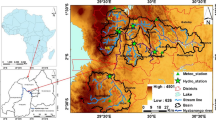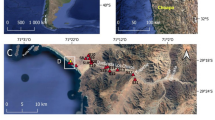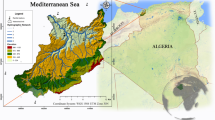Abstract
Understanding the sediment source is very significant for erosion control in small watersheds. On the Loess Plateau of China, over 110 thousands of check dams were constructed in the past 60 years, which played an important role in controlling soil loss and also kept much information of erosion and sediment yield in the past. The objective of this investigation is to identify the sediment source by the 137Cs tracing method in a small watershed in the Loess Hilly Region of China. Fifty-five sampling sites were selected from the watershed (44 from the inter-gully area, 7 from the gully sides and 4 from the reference sites), and a total of 114 soil samples were collected from three sediment profile cores at the Sidizui watershed check dam constructed in 1959. Based on the erosion rate from the inter-gully area by the 137Cs models, and the total erosion amount deposited in the check dam since 1963, the relative contributions of sediment from the inter-gully area and gully area were estimated during 1963–2013. By comparing the difference of 137Cs activities of surface soils from the check dam (deposited in the 2011–2013 flood events), the inter-gully and gully areas, the relative contributions of sediment derived from the two source areas to the flood sediment during recent years (2011–2013) were estimated by a simple mixing model. Results showed that the erosion rate from the inter-gully area was about 3054 t/km2 a during 1963–2013, and the relative contributions of sediment from the inter-gully area and gully area were estimated to be 27 and 73%, respectively. The sediment from the inter-gully area was about 20% of the total sediment yield amount to the 2011–2013 floods, and from the gully area it was about 80%. The relative contribution of sediment from the inter-gully or gully area was not a fixed value in the watershed. Both of the inter-gully erosion and gully erosion should be simultaneously controlled, and more erosion control measures on the gully area should be taken in the subsequent watershed management in order to reduce the erosion amount in this region.





Similar content being viewed by others
References
Boardman J, Foster IDL (2011) The potential significance of the breaching of small farm dams in the Sneeuberg region, South Africa. J Soils Sediments 11(8):1456–1465
Boix-Fayos C, Vente JD, Martínez-Mena M, Barberá GG, Castillo V (2008) The impact of land use change and check-dams on catchment sediment yield. Hydrol Process 22(25):4922–4935
Chen H (1999) Sediment source on small basin in the Middle Reaches of Yellow River. J Soil Erosion Soil Conserv 5(1):19–26
Collins AL, Walling DE, Sichingabula HM, Leeks GJL (2001) Using 137Cs measurements to quantify soil erosion and redistribution rates for areas under different land use in the Upper Kaleya River basin, southern Zambia. Geoderma 104:299–323
Ding WF, Li M (2016) Effects of grass coverage and distribution patterns on erosion and overland flow hydraulic characteristics. Environ Earth Sci 75(6):477
Feng GA, Zheng BM (1998) Revelation of the comprehensive treatment in the Wangmaogou watershed in North Shaanxi. Yellow River 20(1):18–20
Foster IDL, Walling DE (1994) Using reservoir deposits to reconstruct changing sediment yields and sources in the catchment of the Old Mill Reservoir, South Devon, UK, over the past 50 years. Hydrol Sci J 39(4):347–368
Gema G, Quinton JN, Nearing MA, Mabit L (2013) Sediment tracers in water erosion studies: current approaches and challenges. J Soils Sediments 13(4):816–833
Gong SY, Jiang DQ (1978) The soil loss and treatment in a small watershed in Loess Hilly Region in the Middle Reaches of Yellow River. Sci China 6:671–678
He Q, Walling DE, Owens PN (1996) Interpreting the 137Cs profiles observed in several small lakes and reservoirs in southern England. Chem Geol 129(1):115–131
Hu YF, Liu JY, Zhang DF, Cao HX, Yan HM, Yang FT (2005) Distribution characteristics of 137Cs in wind-eroded soil profile and its use in estimating wind erosion modulus. Chin Sci Bull 50(11):1155–1159
Jia SR (1992) Study on the runoff and sediment coming from the first Loess Hilly-gullied subregion. Soil Water Conserv China 1:20–23
Jiang DQ, Zhao CX, Chen ZL (1966) Preliminary analysis on the source of runoff and sediment in the Middle Reaches of Yellow River. Acta Geogr Sin 32(1):20–34
Jiang ZS, Wang ZQ, Liu Z (1996) Quantitative study on spatial variation of soil erosion in a small watershed in the Loess Hilly Region. J Soil Water Conserv 10(1):1–9
Jiao JY, Liu YB, Tang KL (1992) An approach to runoff and sediment generation of gully and intergully land in small watershed. J Soil Water Conserv 6(2):24–28
Li Y, Poesen J, Yang JC, Fu B, Zhang JH (2003) Evaluating gully erosion using 137Cs and 210Pb/137Cs ratio in a reservoir catchment. Soil Tillage Res 69(1):107–115
Li M, Yang JF, Hou JC, Shen ZY (2008) Sediment deposition process for a silt dam in a small watershed in Loess Hilly Region. Trans Chin Soc Agric Eng 24(2):64–69
Li M, Yang JF, Hou JC, Shen ZY (2009) The spatial variance of hill slope erosion in Loess Hilly Area by 137Cs tracing method. Nucl Tech 32(1):50–53
Li M, Yao WY, Shen ZZ, Yang JS, Yang E (2016) Erosion rates of different land uses and sediment sources in a watershed using the 137Cs tracing method: field studies in the Loess Plateau of China. Environ Earth Sci 75:591
Li M, Li P, Yang E, Bao HZ, Shen ZZ, Wei GJ (2017) Characteristics of sediment retention and transport in small watershed after construction of check dams in Loess Hilly Area. Trans Chin Soc Agric Eng 24(2):64–69
Liu LF, Jin SQ, Fu MS, Wang Z, Wang K (2015) Study on the characteristics of erosion and sediment yield based on the information in check dam. Soil Water Conserv Sci Tech Shanxi (1):10–13
Ma SB (2013) Impact of small basin underlying surface measures change on sediment transport. Yellow River 35(1):78–80
Martz LW, De Jong E (1991) Using cesium-137 and landform classification to develop a net soil erosion budget for a small Canadian prairie watershed. Catena 18:289–308
Olley JM, Murray AS, Mackenzie DH, Edwards K (1993) Identifying sediment sources in a gullied catchment using natural and anthropogenic radioactivity. Water Resour Res 29:1037–1043
Owens PN, Walling DE (1996) Spatial variability of caesium-137 inventories at reference sites, an example from two contrasting sites in English and Zimbabwe. Appl Radiat Isot 47(7):699–707
Romero-Díaz A, Alonso-Sarriá F, Martínez-Lloris M (2007) Erosion rates obtained from check-dam sedimentation (SE Spain). A multi-method comparison. Catena 71:172–178
Simms AD, Colin W, Brian GJ, Jones BG, Heijnis H, Mann RA, Harrison J (2008) Use of 210Pb and 137Cs to simultaneously constrain ages and sources of post-dam sediments in the Cordeaux reservoir, Sydney, Australia. J Environ Radioact 99(7):1111–1120
Tang KL (1990) The characteristics of soil erosion and its prevention and control in the Loess Plateau Region. Science and Technology Press of China, pp 117–132
Walling DE (2005) Tracing suspended sediment sources in catchments and river systems. Sci Total Environ 344:159–184
Walling DE (2013) The evolution of sediment source fingerprinting investigations in fluvial systems. J Soils Sediments 13(10):1658–1675
Wang YF, Chen LD, Fu BJ, Lü YH (2014) Check dam sediments: an important indicator of the effects of environmental changes on soil erosion in the Loess Plateau in China. Environ Monit Assess 186:4275–4287
Wei X, Li ZB, Shen B, Li XG, Lu KX (2006) Depositing process of check dams on loess plateau in Northern Shaanxi Province. Trans Chin Soc Agric Eng 22(9):80–84
Wu YH, Kou Q (1997) The method of 137Cs to study soil erosion in the Loess Gully Area of east Gansu province. Bull Soil Water Conserv 17(5):7–10
Xu JX (2004) Recent tendency of sediment reduction in the middle Yellow River and some countermeasures. J Sediment Res 2:5–10
Xu XZ, Zhang HW, Zhang OY (2004) Development of check-dam systems in gullies on the Loess Plateau, China. Environ Sci Policy 7:79–86
Yang MY, Tian JL, Liu PL (2006) Investigating the spatial distribution of soil erosion and deposition in a small watershed on the Loess Plateau of China, using 137Cs. Soil Tillage Res 87:186–193
Zeng BQ (1980) Soil loss mechanism and its control in Loess Hilly Region in West Shanxi. Yellow River 2:20–25
Zhang XB, Wen AB (1999) Using cesium-137 to estimate rate of soil erosion in the Loess Plateau of China. In: Management of ecological environment in the Loess Plateau of China—proceedings of CCAST (World Laboratory) workshop. China Center of Advanced Science and Technology, pp 117–132
Zhang X, Walling DE, Quine TA, Wen A (1997) Use of reservoir deposits and caesium-137 measurements to investigate the erosional response of a small drainage basin in the rolling loess plateau region of China. Land Degrad Dev 8(1):1–16
Zhang XB, Wen ZM, Feng MY, Yang QK, Zheng JJ (2007) Application of 137Cs fingerprinting technique to interpreting sediment production records from reservoir deposits in a small catchment of the Hilly Loess Plateau, China. Sci China 50(2):254–260
Zhang L, Shi CX, Zhang H (2010) Effects of check-dams on sediment storage-release in Chabagou watershed. Trans Chin Soc Agric Eng 26(2):64–69
Zhao GJ, Klik A, Mu XM, Wang F, Gao P, Sun WY (2015) Sediment yield estimation in a small watershed on the northern Loess Plateau, China. Geomorphology 241:343–352
Acknowledgements
This study was supported by the National Nature Science Foundation of China (No. 41371284) and the Fundamental Research Funds of the Yellow River Institute of Hydraulic Research (HKY-JBYW-2017-02). The authors would like to thank two anonymous reviewers for their comments considerably improving the quality of the paper.
Author information
Authors and Affiliations
Corresponding author
Rights and permissions
About this article
Cite this article
Li, M., Yang, E., Li, P. et al. Identifying sediment sources from the inter-gully area and gully area in a small watershed in the Loess Hilly Region of China. Environ Earth Sci 76, 776 (2017). https://doi.org/10.1007/s12665-017-7114-7
Received:
Accepted:
Published:
DOI: https://doi.org/10.1007/s12665-017-7114-7




